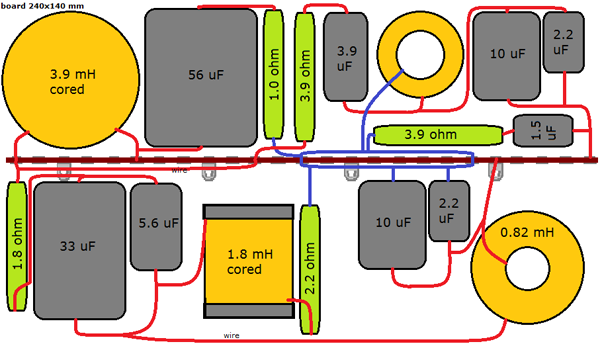Get 90 dB/2.8V and a valve friendly impedance.
Copyright 2010-14 © Troels Gravesen
Discontinued. Kit no longer available from Jantzen Audio.
CROSSOVER CABINET MEASUREMENTS
Check out new mkII version here. Same work and cost and better sound!
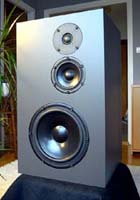
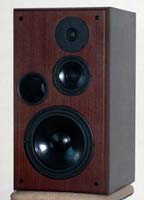
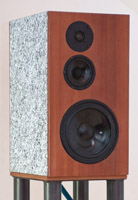
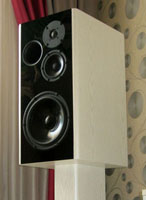
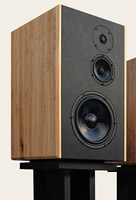
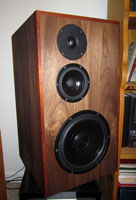
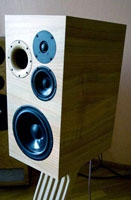
The 3-way Classic is popular and above some builders'
results. Classic style, cool style, rock solid (marble) style, etc. Go to
Builders' Response page to view more.
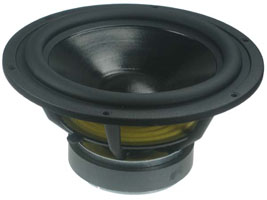
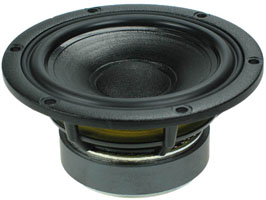
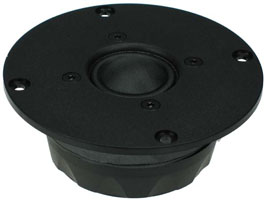
Download drivers' data:
SEAS CA22RNX +
MCA12RC +
27TFFC
An 8" bass driver, a 4" midrange driver and a tweeter was very much what could have been on the agenda in the Seventies and except for the dome tweeter, these drivers could have been right out of the Seventies. Well, the spider chassis are new, but cones, surrounds and voice coils haven't changed much over the years. I do believe dome tweeters have improved significantly since then. The most common Audax and Peerless domes of the Seventies were not the last thing in this area.
Two 37 litre vented boxes were at hand and from the TS measurements of the CA22 driver a reasonably bass performance could be achieved. The SEAS 27TDC and 27TFFC were available and the 27TFFC appeared to have the smoothest sound so this one was chosen for the final design. These two tweeters were readily interchangeable without any modifications to the crossover.
These SEAS paper coned drivers takes some break-in. I've never experienced the magnesium drivers to change much over time, but in particular the CA22 bass drivers will take some heavy massage to come to life. The CA22 TS data suggest this driver to be close in performance to the EXCEL W22 driver, but here we have some 5-7 litres less volume and the CA22 does not reach quite as deep as the W22. We'll later see how the CA22 performs in the 45 litres wide baffle cabinets. My calculation predicts a F3 of 43 Hz. Not bad from a 37 litres cabinet and with a 90 dB sensitivity. The W22 has a little more cone weight, approx. 3 grams and the Qm, Qe and Qt are basically the same. Fs is lower for the W22 and Vas a little higher. So the CA22 is basically a lightweight paper cone and so it appears from the initial listening tests. Bass is speedy and transient but does not have the deep grip of the W22 or the ScanSpeak 18W/8531G00, BUT compared to the 18W/8531 it's around 4-5 dB more sensitive for the same voltage applied. And that makes a difference. Considering the cabinet size I'm sure the CA22 will perform very close to the W22 from a 45 litres cab.
The MCA12 is a darling. What you immediately recognise from this construction is the unusual wide dispersion of the midrange. If you're used to listening to 2-ways with a 6-7" midbass, the sound from the 3W Classic will be very much different. Besides the midrange dispersion, the MCA12 is fast as lightning and you will get a transients attack not possible from 15 grams 6" cones. The 4" middriver may be one of the clues to "an easy to listen to" speaker: http://www.troelsgravesen.dk/HES.htm.
The 27TFFC just does what it's supposed to do. No more, no less. This is a magnificent tweeter. No wonder it has found its way into a number of British speakers like the ProAc Studio 100 monitor.
I had expected the overall level of transparency to be compromised from the old time front panel layout, but this doesn't seem to be the case. And why should it? A lot of studio monitors are still built this way. Take a look at ATC monitors. The same configuration of drivers as seen here. Transparency is excellent - probably thanks to the MCA12. I would certainly place the vent on the rear panel to reduce any midrange escaping from here, but stuffing the vent doesn't seem to do much to the quality of the midrange.
Having
the TJL3W aside, these speakers were an obvious
choice for comparison. Two quite different speakers - and
quite different prices too.
Having had the 3W-Classics on the stand for a couple of
weeks I put back the TJL3Ws, which was - a little
disturbing.
Now, the TJL3W has some 5 dB less sensitivity but it does
not make a major difference to my 50 wpc valve power amp.
But surely I do not have to turn up the volume much when
the 3W Classics are connected.
What is immediately clear from this comparison is the deeper bass from the TJL3W - and the overall tonal neutrality. The magnesium drivers' lack of colouration is hard to ignore. And I also suspect the 4th order filters of the TJL3W for being responsible for the lack of drivers overlapping and causing reduced distortion and coloration. But this is a controversial subject. I firmly believe there are benefits and trade-off from both approaches and I don't subscribe to any fixed belief of the "right" way of doing things. It all depends. Whether derived from the paper cones or low-order filters, the 3W-Classics have more "lushness" to the sound. They are more coloured, but in a sympathetic - and quite energetic way. It can be played loud, quite loud actually, but the more you push drivers driven by low-order filters the more driver interaction there will be and it starts smearing the sound.
A visitor was quite impressed with the sound but couldn't help noticing that these speakers certainly didn't look nice! Well, all depends on the eye that sees, but try imagine the speakers wrapped in exotic veneers - like some of British classics from Spendor or Harbeth - and they may start looking quite attractive. Maybe even a front grille might do here. The baffle is so wide that a grille frame might only do minor damage to the sound.
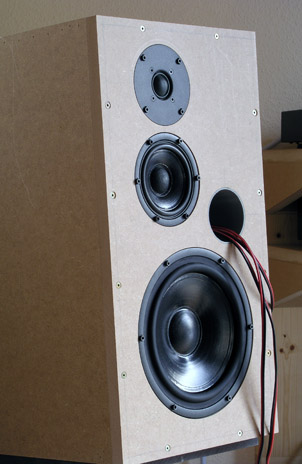
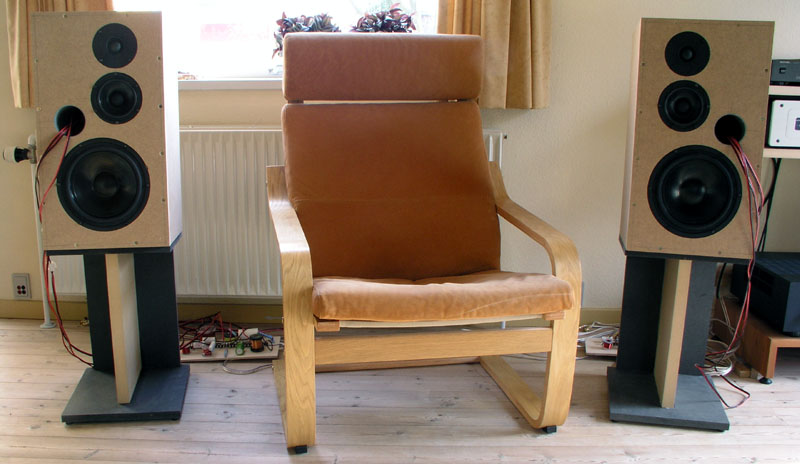
Living room set-up with test crossovers at the floor.
Two stands were made to lift the cabs into proper height.
Top panel of stands were tilted 5 deg.
Getting an old time, 3-way classic into proper listening height may pose a problem. We need the mid and tweeter at ear height from our listening position and these "slim" stands makes the speaker seem less bulky than I would have thought. Do not make a stand having a "front panel" as an extension of the speaker front panel. The bass driver reaches up to 500 Hz and a larger front panel will change the sound radically.
These drivers are easy! Simple second order filters
-except for tweeter - and all fall into place.
CROSSOVER LAYOUT
WIRING
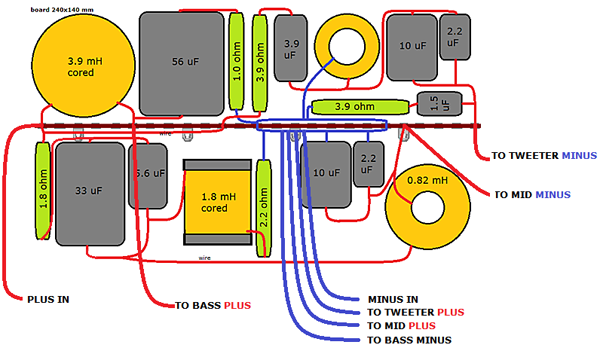
The 3-Way Classic Kit
BACK TO
INDEX
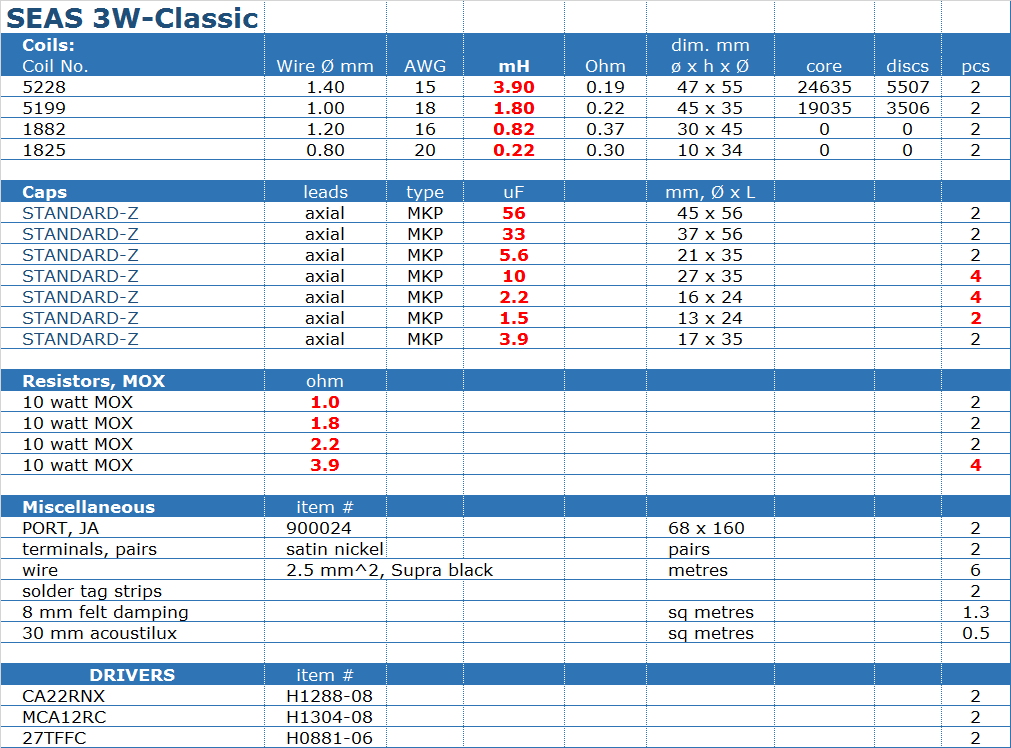
Kit no longer available from Jantzen Audio.
All technical questions to troels.gravesen@hotmail.com
A few comments on MEASUREMENTS before you start interpreting all the readings below. First of all, if you think measurements will tell you how a speaker sounds, you're wrong, very much wrong indeed. The perception of sound is way too subjective to be reflected in any measurements we can perform. A loudspeaker system is meant to give us a satisfying idea of an acoustic event and for some people a pair of 5 USD ear-plugs are enough, others spend 200 kUSD on a truly full-range pair of speakers - and the latter may not be happier than the former. Measurements may give us an idea of tonal balance of a system, i.e. too much or too little energy in certain areas. Measurements may tell us about bass extension if far-field measurements are merged with near-field measurements. In addition to this, ports may contribute to bass extension. Most of us diy'ers do not have access to an anechoic room for full-range measurements from 20-20000 Hz. What cannot be seen is what kind of bass performance we get in a given room. Bass performance is highly dependent on in-room placement of your speaker and the same speaker can be boomy in one place and lean in another. Actual SPL level at 1 meter distance and 2.8V input is useful for en estimate of system sensitivity and combined with the impedance profile may give an idea of how powerful an amplifier is needed to drive the speaker to adequate levels. What measurements do not tell is the very sound of the speaker unless displaying serious linear distortion. The level of transparency, the ability to resolve micro-details, the "speed" of the bass, etc., cannot be derived from these data. Distortion measurements rarely tell much unless seriously bad, and most modern drivers display low distortion within their specified operating range. Many people put way too much into these graphs and my comments here are only meant as warning against over-interpretation. There are more to good sound than what can be extracted from a few graphs. Every graph needs interpretation in terms of what it means sonically and how it impacts our choice of mating drivers, cabinet and crossover design. What measurements certainly do not tell is the sonic signature of the drivers, because cones made from polyprop, alu, kevlar, paper, glass fiber, carbon fiber, magnesium, ceramics or even diamonds all have their way of colouring the sound.
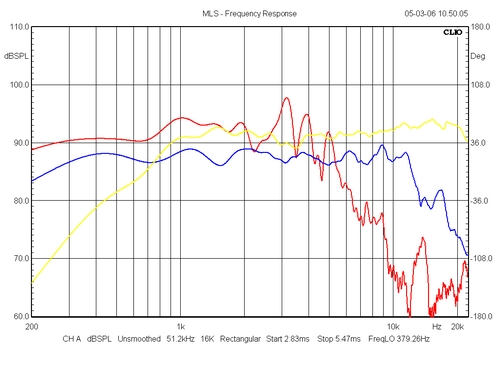
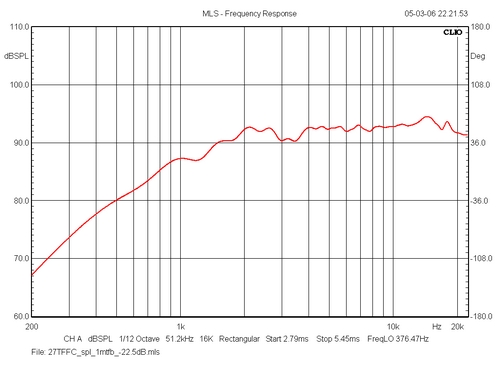
Left:
Response of individual drivers. Mid and tweeter performs
very well and the bass (red) has trouble at 3, 4 and 5
kHz. The dust cap? Well, with a point of crossover
between bass and mid at 500 Hz we needn't worry too much
what the bass does above 3 kHz.
The MCA12 (blue) really performs well. Flat from 300 Hz
to 12 kHz. Couldn't ask for more.
The 27TDC (yellow) appear to work perfectly from this
panel and it's actually quite sensitive. 8 ohms and 92
dB/2.8V - excellent. The TDC was later replaced by the
27TFFC.
Right: Response of 27TFFC, slightly earlier roll-off
compared to 27TDC.
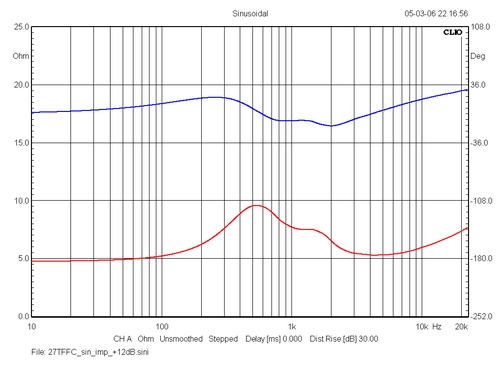
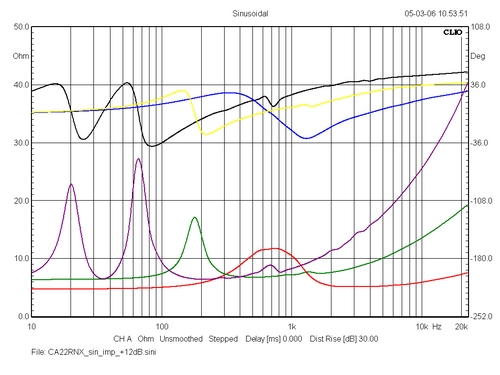
Left: Impedance of 27TFFC. Typical ferro-fluid profile. Right: Impedance and phase of individual drivers (here the 27TDC tweeter). With a port of 68 x 130 (WxL) we get a vent tuning of ~35 Hz. A slightly shorter vent may boost bass between 50 and 100 Hz but I didn't try this.
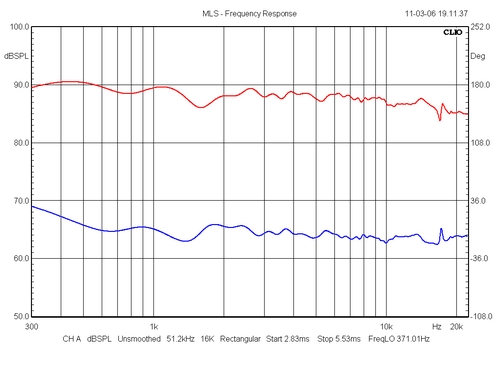
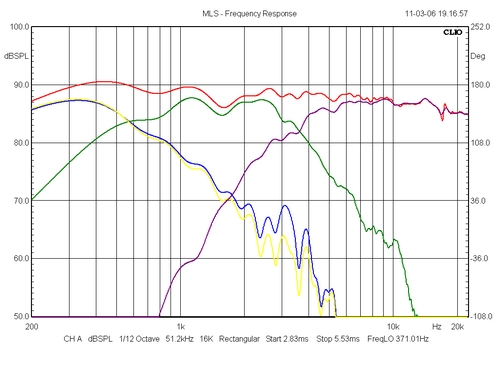
Left: So
here we have the measured response (red) from the
speaker. System sensitivity is around 90 dB and the
speakers has a minor BBC dip towards higher frequencies
to gain a natural balance sound. Blue = minimum phase.
Right: Frequency response of individual drivers. The
break-up of the bass cone around 3-4 kHz can be further
reduced by a LCR circuit: 0.47 mH + 2R2 + 4.7 uF. Whether
this is audible at all is up to you.
T.jpg)
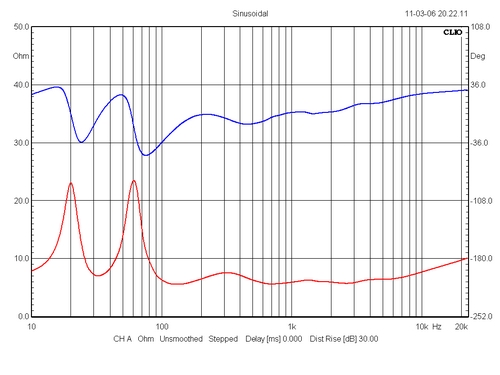
Left: The
most difficult test: What happens if you invert polarity
of the middriver? What is seen are two deep suck-outs
around points of crossover suggesting excellent phase
tracking between drivers.
Right: Impedance profile of system. THIS is a flat impedance profile and
a steady 5-6 ohms are for valve lovers. The vent tuning has gone down a
bit from applying more damping material. Vent length is kept at 130 mm
for 68 mm diameter.
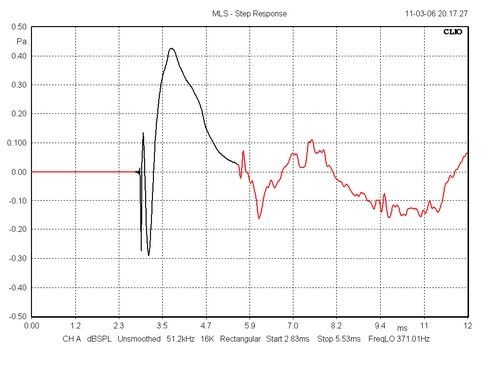
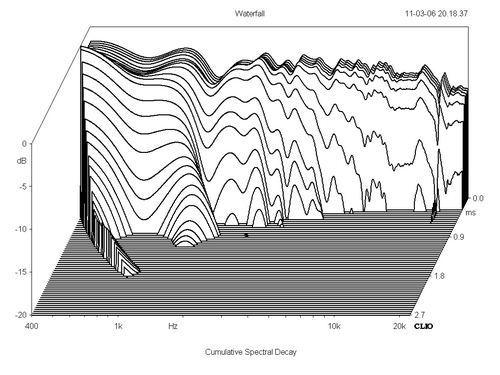
Left: Step
response of system. Note negative polarity of tweeter and
middriver and the smooth decay of the bass driver's
response.
Right: Cumulative spectral decay - for what it may be
worth. I suggest making a significantly more rigid
cabinet than the tests cabs used here, but more on this
later.
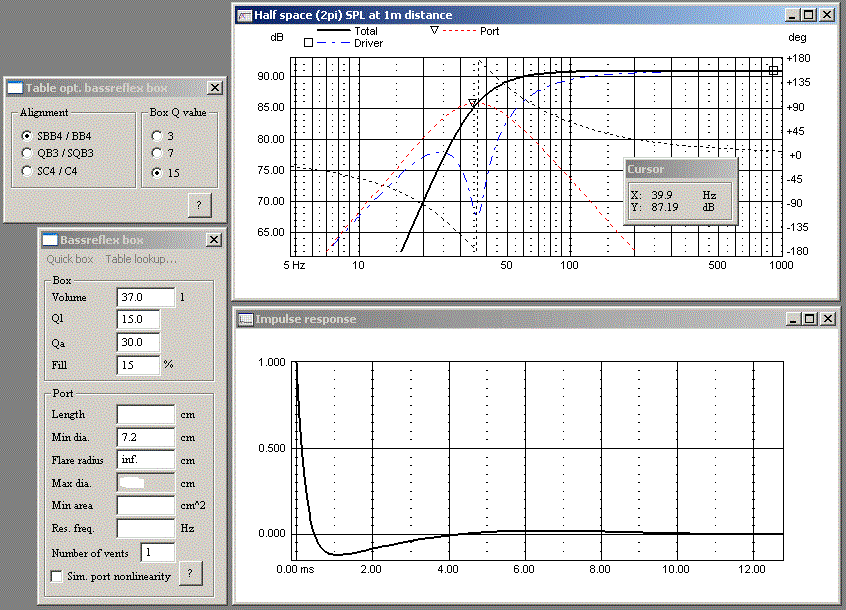
Screen shot from cab simulation.
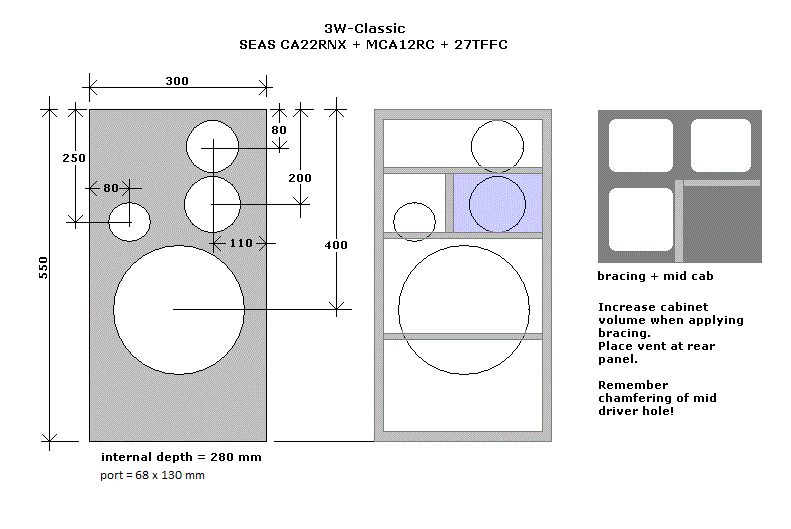
Only a few words on
cabinet construction. What's depicted above is my test
cabinet set-up and if you want to take advantage of the
crossover you have to use these front panel dimensions
and in particular the drivers' placement.
The cabs were made from 19 mm MDF and are 300 x 550 x 320
mm (W x H x D) producing a volume of approx. 37 litres.
The mid cab and the vent will reduce the volume by some 2
litres.
I suggest a port tuning of 35 Hz requiring a port of 130 mm length for
68 mm diameter.
I strongly suggest making a cabinet with several bracings
as seen on the drawing. If you make the mid cab from MDF,
make it at least 1.5 litres in volume. Take a look at the
L26-3way to get some ideas on cabinet making and
damping.
CABINET
DAMPING:
Add 8 mm felt material to all internal panels
except front. Place two layers of acoustilux behind bass driver and 2
layers at bottom or top. Add one layer of acoustilux behind middriver.
That's all.
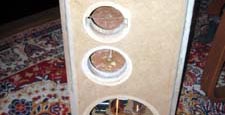
When I'm talking about chamfering driver holes, I'm
serious. What's seen above is
from a 3W-Cl builder having the middriver in a much too
deep tube - and it impacts
the sound badly. Read here about chamfering driver holes:
The importance of chamfering
driver holes. A small study.
3WC-Classic,
built by Marshall
3W-Classic, built by Nazar, US
3W-Classic, built
by Mr. Wang, China
3W-Classic,
built by Egor
3W-Classic, built by Victor, Ukraine
3W-Classic,
built by Federico, Italy
3W-Classic,
built by Yan Bertrand
3W-Classic, built
by Denis, Russia
3W-Classic, built by Andrew K./US
3W-Classic, built by Andrew/Ukraine
3W-Classic, built by Jonatan
3W-Classic, built by
Max/Ukraine
3W-Classic,
built by Björn/Sweden
3W-Classic, built
by Slawek/Poland
3W-Classic, built by Pawel/Poland
3W-Classic, built by Richard Kuba/Slovakia
3W-Classic, built by Stephen/US
3W-Classic,
built by Jan/Canada
